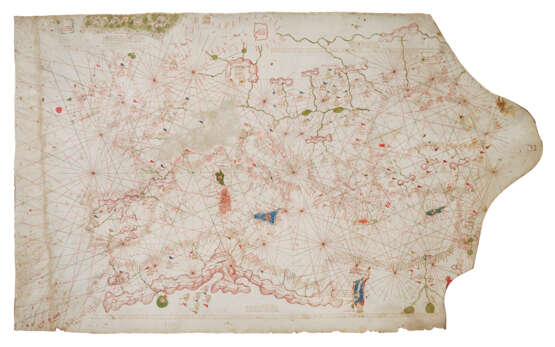ID 820113
Lot 566 | Portolan chart of Europe
Valeur estimée
$ 100 000 – 150 000
[Genoa, c.1500-1525]
Highly unusual portolan chart depicting the whole of Europe. The chart appears to derive from several sources, borrowing the main features from the comparatively austere 15th century Italian charts of the Mediterranean (the most typical subject of portolan charts) and embellishing it with decorative forms of mountain depiction, and adding a most unusual depiction of Norway. The fact that the island of Malta is not decorated with the Cross of the Knights of St. John suggests a date before 1530, while the depiction of Crete with the Venetian Lion symbol is unusual, a crest being the normal way of decoration. This chart is a fine example of how the undecorated style of the Italian chart-maker became influenced by later Catalan traditions. It was undoubtedly produced for display for a wealthy Genoese client, whose trade interests were spread beyond the Mediterranean.
Some of the features of Catalan influence include the use of arms decorating the islands and the depiction of the figure of Solomon, yet the form and type of flag depiction, absence of compass roses and of symbols to Majorca and the overall style of the chart reflect the austerity of Italian 15th-century charts. This chart is idiosyncratic in several ways: the depiction of Norway is unique; two rhumbline systems at the center of the Mediterranean are misregistered; and the extension vellum strip for the Atlantic islands suggests a miscalculation. These anomalies may be due to the chart-maker’s inexperience. That—and the fact that we find that no direct relation of this portolan chart to any other documented one—suggest that it is one of very few made or even unique. In any case, while all portolan charts are rare, portolan charts of the whole of Europe on one skin are very unusual. They more typically depict only either the Atlantic coast or the Mediterranean.
Manuscript portolan chart, ink and colors on vellum sheet, maximum dimensions 670 x 1120mm., including an extension section to accommodate the Atlantic Islands, verso blank, the chart extending from the Canaries to the Sea of Azov, from Norway and Iceland to the Nile, coastlines in sepia, islands in red, blue and green, rivers and lakes in green, over 1200 place-names in red and sepia in a small neat gothic rotunda, 76 detailed town vignettes, including all the major towns of the Mediterranean and the capitals of Northern and central Europe, all surmounted by flags occasionally heightened in silver or gold, mountains in North Africa, Spain and Northern Europe in crimson elongated formations, the islands of Corsica, Sardinia, Sicily, Crete and Cyprus decorated with flag symbols, large image of King Solomon holding a pair of dividers depicted in Egypt, the area of Norway decorated with a carefully drawn scene of mountains, sea-birds and a castle. Four scale bars set in the upper and lower margins, the chart extending through the northern scale bars, rhumblines in sepia, red and green, seven descriptive notes for the areas of northern Africa, Iceland, Norway, a Baltic island, two for Russia and a note for King Solomon. Framed.
Provenance
John Alfred Spranger, bequeathed to his daughter Elizabeth Graff.
‌The Property of Elizabeth Graff; Christie’s, 12 May 1993, lot 168.
‌Acquired by Ann and Gordon Getty from the above.
| Lieu d'origine: | Italie, Europe |
|---|---|
| Catégorie maison de vente aux enchères: | Cartes et Atlas |
| Lieu d'origine: | Italie, Europe |
|---|---|
| Catégorie maison de vente aux enchères: | Cartes et Atlas |
| Adresse de l'enchère |
CHRISTIE'S 20 Rockefeller Plaza 10020 New York Etats-Unis | ||||||||||||||
|---|---|---|---|---|---|---|---|---|---|---|---|---|---|---|---|
| Aperçu |
| ||||||||||||||
| Téléphone | +1 212 636 2000 | ||||||||||||||
| Fax | +1 212 636 4930 | ||||||||||||||
| Conditions d'utilisation | Conditions d'utilisation | ||||||||||||||
| transport |
Service postal Service de messagerie ramassage par vous-même | ||||||||||||||
| Modes de paiement |
Virement bancaire | ||||||||||||||
| Heures d'ouverture | Heures d'ouverture
|





